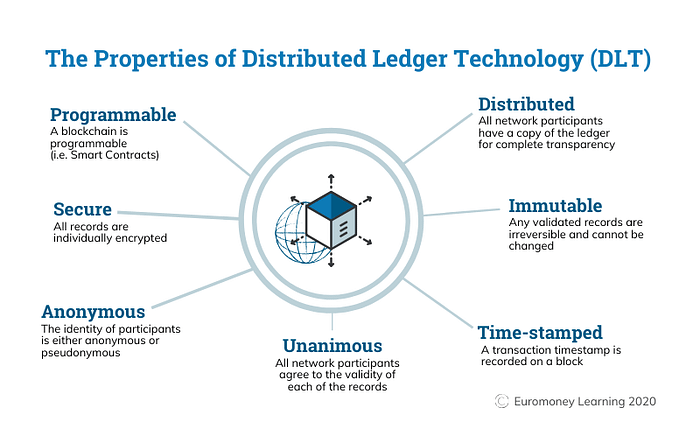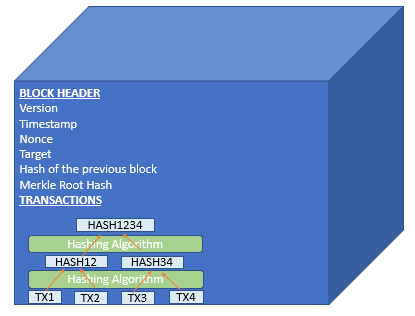Blockchain is poised to transform every industry and managerial function—redefining the ways we transact online, share ideas, and manage workflows…
To lead the way on next-generation hyperscalers, we will invest in blockchain, high-performance computing, quantum computing, algorithms and tools to allow data sharing and data usage.
Ursula von der Leyen, President of the European Commission – Excerpt from Political guidelines for the next European Commission 2019-2024
Blockchain – Revolution for the Enterprise
Blockchain is a technology (DLT) help record information at each step and make that information available to everyone transparently. Blockchain is poised to transform every industry and managerial function—redefining the ways we transact online, share ideas, and manage workflows. It’s a new technology that every business professional needs to understand.
As a result, all other entities can see who is using and modifying the ledger. This transparency of DLT provides a high level of trust among the participants and practically eliminates the chance of fraudulent activities occurring in the ledger. As such, DLT removes the need for entities using the ledger to rely on a trusted central authority that controls the ledger, or an outside, third-party provider to perform that role and act as a check against manipulation.
DLT is a decentralized database managed by multiple participants, across multiple nodes. Blockchain is a type of DLT where transactions are recorded with an immutable cryptographic signature called a hash. The transactions are then grouped in blocks and each new block includes a hash of the previous one, chaining them together, hence why distributed ledgers are often called blockchains.

A blockchain is a time-stamped series of immutable records of data that is managed by a cluster of computers not owned by any single entity. Each of these blocks of data (i.e. block) is secured and bound to each other using cryptographic principles (i.e. chain).
Blockchain is a system of recording information in a way that makes it difficult or impossible to change, hack, or cheat the system. Most normal databases, such as an SQL database, have someone in charge who can change the entries. Blockchain is different because nobody is in charge; it’s run by the people who use it.
Blockchain is an immutable, distributed, decentralized; peer-to-peer ledger replicated across multiple nodes connected in a network, making it possible to record data about any event or transaction as it happens. Blockchain can be applied to many other applications wherever we want to record transactions securely between two parties without an intermediary.
Its value is not limited to monetary transactions – it also applies to assets, property titles, the rights to a song, a vote, and even a person’s identity – and its application extends far beyond the realm of financial services.
How does a blockchain work?
Using a single transaction as an example, when a transaction is created on the blockchain, it will be submitted to a global network of computers. These computers will either verify the transactions instantly or it will be placed in a queue of pending transactions for nodes to validate based on the rules set by the network.
The responsibility falls upon all the individual nodes of the network and the process used to verify the transaction. Once verified, the transaction is recorded chronologically and cannot be changed.
This network consensus is the basis of the blockchain network architecture. There are several different consensus algorithms but they all consist of the following primary objectives — coming to an agreement, collaboration, co-operation, equal rights, participation and activity.
Blockchain possesses important characteristics to transform existing products and services, and enable new innovative solutions:
- Disintermediation: enables peer-to-peer interactions which can be trusted based on public & private key enabled signatures
- Smart contracts: continuous near real-time tracking of data through the use of smart contracts
- Auditability: provides a full audit trail of data, creating a means of record keeping
- Immutability: all blockchain transactions are timestamped and tamper-proof providing a single source of data integrity.
At its core, blockchain is a trust machine enabling transparency through collaborated efforts.
Security
- Immutability: Blocks in blockchain are write-once append-only. Data in every block is encrypted using the SHA-256 algorithm that makes modification to data very difficult. Any change in the data renders the newly modified block invalid. This ability of blockchains prevents alteration of transactions.
- Consensus: Nodes within a distributed blockchain network have to agree on the network’s true state to ensure the validity of transactions using Proof of Work or Proof of Stake.
- Transparency: Blockchain is distributed across multiple nodes across the entire network of computers. If one user tries to forge a transaction in the blockchain, all other nodes in the blockchain network will cross-reference each other and easily pinpoint the node with the incorrect information.
A Block
A Block in a Blockchain record transaction or transactions to organize, monitor, and control information for informed decision making.
Every time a new transaction occurs on the blockchain, a record of that transaction is added as a new block to the chain. The new block is added to every participant’s nodes ledger only after applying a consensus algorithm like proof of work to validate the transaction. A block in the chain is immutable. It can never be updated and only be appended to the chain.

The Block consists of a block header containing metadata:
- Version number to track the software or protocol that will allow other computers to read the block correctly.
- Timestamp: when the transaction was recorded, or the block was created and is expressed as seconds since 1970–01–01T00:00 UTC.
- 256 bit Cryptographic hash of the previous block header that links one block with another block in a Blockchain. This ensures the integrity of the previous block all the way back to the first block referred to as a Genesis block.
- Nonce stands for number only used once. The nonce is a randomly generated number that miners generate to solve a complex mathematical problem to create a block.
- The target represents the difficulty of generating the nonce, which validates a transaction before it is added to a blockchain. It regulates the speed at which new blocks are added to the blockchain and are adjusted roughly every 2016 block. Higher difficulty in generating the nonce represents a lower target value.
- A hash for all the transactions in a block.
How is a transaction recorded in a Blockchain?
Blockchain miners install and run a special Blockchain mining software that enables their computers to communicate securely with one another. Once a computer installs the software, joins the network, and begins mining, it becomes what is called a ‘node.’
- Step 1: Sender or Originator of Transaction digitally signs the transaction: digital signatures are a fundamental building block in blockchains; they are primarily used to verify the authenticity of transactions
- Step 2: Transaction is broadcasted to the network: it gets verified by all of the available Blockchain nodes
- Step 3: Nodes authenticates the transaction
- Step 4: Valid transactions are stored in mempool: the mempool stores all valid transactions waiting to be confirmed by the network.
- Step 5: Miners validate using consensus to add the block: to add a new block to the blockchain, a computational puzzle must be solved to encrypt the block’s data.
With the evolution of blockchain technology, various new decentralized platforms have surfaced now with distinctive features. Therefore, it is complex to analyze and decide which is the most suited one per the need of the business. Shortlisting and then selecting one appropriate blockchain protocol requires a lot of research, analysis and comparison. A parallel comparison of the blockchain platforms is important for the evaluation of the variety of features that they offer.





